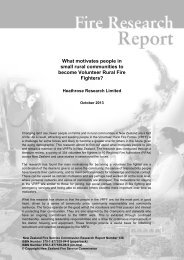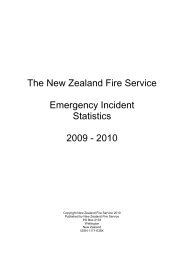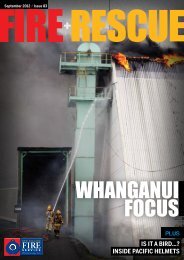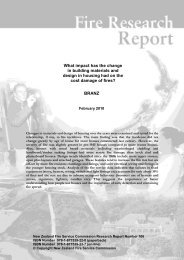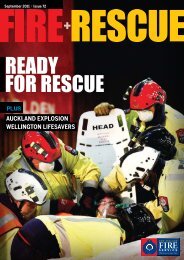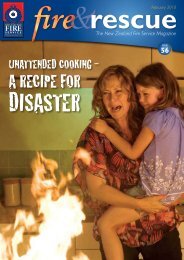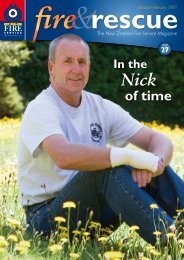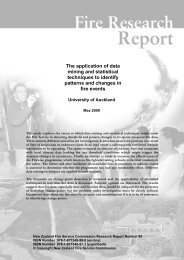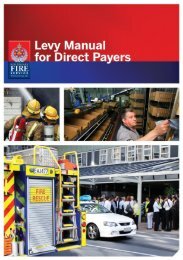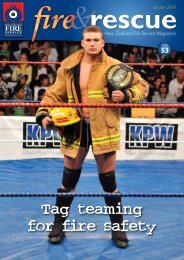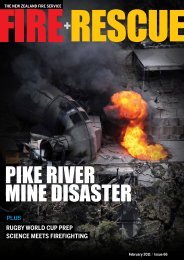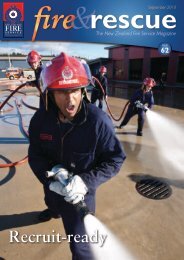FIRE BOMB - New Zealand Fire Service
FIRE BOMB - New Zealand Fire Service
FIRE BOMB - New Zealand Fire Service
You also want an ePaper? Increase the reach of your titles
YUMPU automatically turns print PDFs into web optimized ePapers that Google loves.
‘Bad drivers’ provide<br />
Heathcote Valley training<br />
You could be forgiven for thinking that the Heathcote Valley in eastern Christchurch<br />
had suffered an epidemic of bad driving with multiple car accidents and responding<br />
emergency services during recent training exercises.<br />
By SSO Dave Stackhouse,<br />
MVA Trainer, CHCH Metro<br />
The realistic exercises were part of<br />
this year’s week-long Black Watch<br />
MVA course at Woolston training<br />
centre. The course is made up of<br />
a mixture of firefighters from<br />
Christchurch and Timaru with a<br />
variety of service personnel who<br />
either need further consolidation<br />
from recruit training or are newly<br />
transferred into PRT stations.<br />
The course participants work through<br />
theory in systematic rescue to learning<br />
how the various PRT rescue tools<br />
work, and field problem solving to<br />
straight vehicle extrication techniques.<br />
Fellow instructor SSO Dave Mitton<br />
reckons the most valuable training<br />
philosophy is the shift to impact<br />
damaged vehicle entrapment training.<br />
“The real learning comes when the<br />
course moves to impact damaged<br />
vehicles, some with manikins trapped<br />
within them,” he says. “Once this<br />
area is mastered they start to learn<br />
and appreciate the critical tool angles<br />
and technique variation required to<br />
effect a quick, safe extrication.”<br />
The course builds in momentum<br />
every day. As soon as participants<br />
have gained confidence in the yard<br />
exercises they move on to road<br />
exercises, which injects realism and<br />
ultimately provides the challenge<br />
and motivation to maximise the<br />
learning experience.<br />
The success of the course depends on<br />
a process of logistics to ensure all<br />
exercises are prepared and staged to<br />
attain each objective or multiple<br />
The <strong>New</strong> <strong>Zealand</strong> <strong>Fire</strong> <strong>Service</strong> Magazine<br />
objectives set. The third instructor,<br />
SO Shane Cole has built up quite a<br />
skill in this field, ensuring course<br />
participants have little down time<br />
moving from each scenario while<br />
working through a methodical plan<br />
of set-up, safety assessment and<br />
removal of all scenario vehicles<br />
and props.<br />
SFF Rob Illingworth delivers a valuable<br />
session on patient care, packaging<br />
and pathways from an Ambulance and<br />
<strong>Fire</strong> <strong>Service</strong> perspective. Rob teaches<br />
from a unique position of being a<br />
FF Abel Esera<br />
prepares the<br />
scoop stretcher<br />
to incline down<br />
to the crash site.<br />
Demonstration<br />
former St John Ambulance paramedic<br />
and is now an operational firefighter.<br />
The ability to relate technical subject<br />
matter into an easy-to-understand<br />
common sense approach is something<br />
that was appreciated by the course<br />
participants and would be a good<br />
model for future training.<br />
The final exercise tests the skills<br />
acquired over the previous week and<br />
allows the lucky OIC ’volunteers’ to<br />
test themselves in the command roles<br />
of a stressful extrication.<br />
SO Steve Butler<br />
co-ordinates the<br />
extrication, with SFFs<br />
Ralph Christophers,<br />
Mathew Sinton and<br />
Joe Naughton after<br />
inclining themselves<br />
and all equipment<br />
down to the crash site.<br />
August 2009<br />
3



